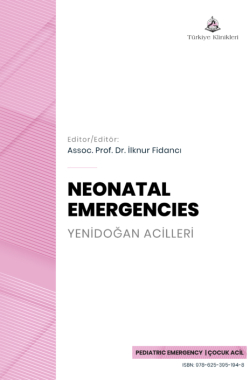A New Definition Different from the Term Apparent Life-Threatening Event: Brief Resolved Unexplained Event
Özlem TEKŞAMa
aHacettepe University Faculty of Medicine, Department of Pediatric Emergency Medicine, Ankara, Türkiye
Tekşam Ö. A new definition different from the term apparent life-threatening event: Brief resolved unexplained event. In: Fidancı İ, ed. Neonatal Emergencies. 1st ed. Ankara: Türkiye Klinikleri; 2024. p.21-7.
ABSTRACT
An apparent life-threatening event (ALTE) is defined as ”an episode that is frightening to the observer and is characterized by some combination of apnea, color change, marked change of muscle tone, choking, or gagging.” This definition cause frequently a diagnostic challenge to the physicians, because the infant is often asymptomatic at presentation. Generally physicians perform more tests or hospitalize patients. All these approaches can cause the patient to unnecessary risk and increase parental anxiety without improving outcomes. Therefore, a brief resolved unexplained event (BRUE) was described recently. With this new definition, a more homogenous patient population is created, and risk stratification and guide management recommendations as lower and higher-risk BRUE for physicians are provided. This guideline is intended to reduce unnecessary medical interventions and laboratory investigations and improve patient outcomes with patient and family-centered care, especially in low-risk patients.
Keywords: Apparent life-threatening event; brief resolved unexplained event; risk stratification; infant; etiology
Kaynak Göster
Referanslar
- McFarlin A. What to do when babies turn blue: beyond the basic brief resolved unexplained event. Emerg Med Clin N Am. 2018;36:335-47. [Crossref] [PubMed]
- National Institutes of Health Consensus Development Conference on Infantile Apnea and Home Monitoring, Sept 29 to Oct 1, 1986. Pediatrics. 1987;79:292-9. [Crossref]
- Fu LY, Moon RY. Apparent life-threatening events: an update. Pediatr Rev. 2012;33:361-8. [Crossref] [PubMed]
- McGovern MC, Smith MBH. Causes of apparent life threatening events in infants: a systematic review. Arch Dis Child. 2004;89:1043-8. [Crossref] [PubMed] [PMC]
- Vigo A, Balagna R, Brazzi L, Costagliola G, Gregoretti C, Lupica et zl. Apparent Life-Threatening Events Helping Infants Help Themselves. Pediatr Emer Care. 2018;34:545-51. [Crossref] [PubMed]
- Radovanovic T, Spasojevic S, Stojanovic V, Doronjski A. Etiology and Outcome of Severe Apparent Life-Threatening Events in Infants. Pediatr Emer Care. 2018;34:687-90. [Crossref] [PubMed]
- Merritt JL, Quinonez RA, Bonkowsky JL, Franklin WH, Gremse DA, Herman BE, et al. A Framework for Evaluation of the Higher-Risk Infant After a Brief Resolved Unexplained Event. Pediatrics. 2019;144:e20184101. [Crossref] [PubMed]
- Tieder JS, Bonkowsky JL, Etzel RA, Franklin WH, Gremse DA, Herman B, et al; Subcommittee On Apparent Life Threatening Events. Brief Resolved Unexplained Events (Formerly Apparent Life-Threatening Events) and Evaluation of Lower-Risk Infants. Pediatrics. 2016;137(5):e20160590. [Crossref] [PubMed]
- Meyer JS, Stensland EG, Murzycki J, Gulen CR, Evindar A, Cardoso MZ. Retrospective Application of BRUE Criteria to Patients Presenting With ALTE. Hospital Pediatrics. 2018;8:740-5. [Crossref] [PubMed]
- Tate C, Sunley R. Brief resolved unexplained events (formerly apparent life-threatening events) and evaluation of lower risk infants. Arch Dis Child Educ Pract Ed. 2018;103:95-98. [Crossref] [PubMed]
- Pierce MC, Kaczor K, Acker D, Webb T, Brenzel A, Lorenz DJ, et al. History, injury, and psychosocial risk factor commonalities among cases of fatal and near-fatal physical child abuse. Child Abuse Negl. 2017;69:263-77. [Crossref] [PubMed]
- DeRidder CA, Berkowitz CD, Hicks RA, Laskey AL. Subconjunctival hemorrhages in infants and children: a sign of nonaccidental trauma. Pediatr Emerg Care. 2013;29:222-6. [Crossref] [PubMed]
- Davies F, Gupta R. Apparent life threatening events in infants presenting to an emergency department. Emerg Med J. 2002;19:11-6. [Crossref] [PubMed] [PMC]
- Ramgopal S, Soung J, Pitetti RD. Brief Resolved Unexplained Events: Analysis of an Apparent Life Threatening Event Database. Academic Pediatr. 2019;19:963-8 [Crossref] [PubMed]
- Ramgopal S, Noorbakhsh KA, Callaway CW, Wilson PM, Pitetti RD. Changes in the Management of Children With Brief Resolved Unexplained Events (BRUEs). Pediatrics. 2019;144:e20190375. [Crossref] [PubMed]
- Tieder JS, Altman RL, Bonkowsky JL, Brand DA, Claudius I, Cunningham DJ, et al. Management of apparent life-threatening events in infants: a systematic review. J Pediatr. 2013;163:94-9.e1-6. [Crossref] [PubMed]
- Tieder JS, Cowan CA, Garrison MM, Christakis DA. Variation in inpatient resource utilization and management of apparent life-threatening events. J Pediatr. 2008;152:629-35. [Crossref] [PubMed]

